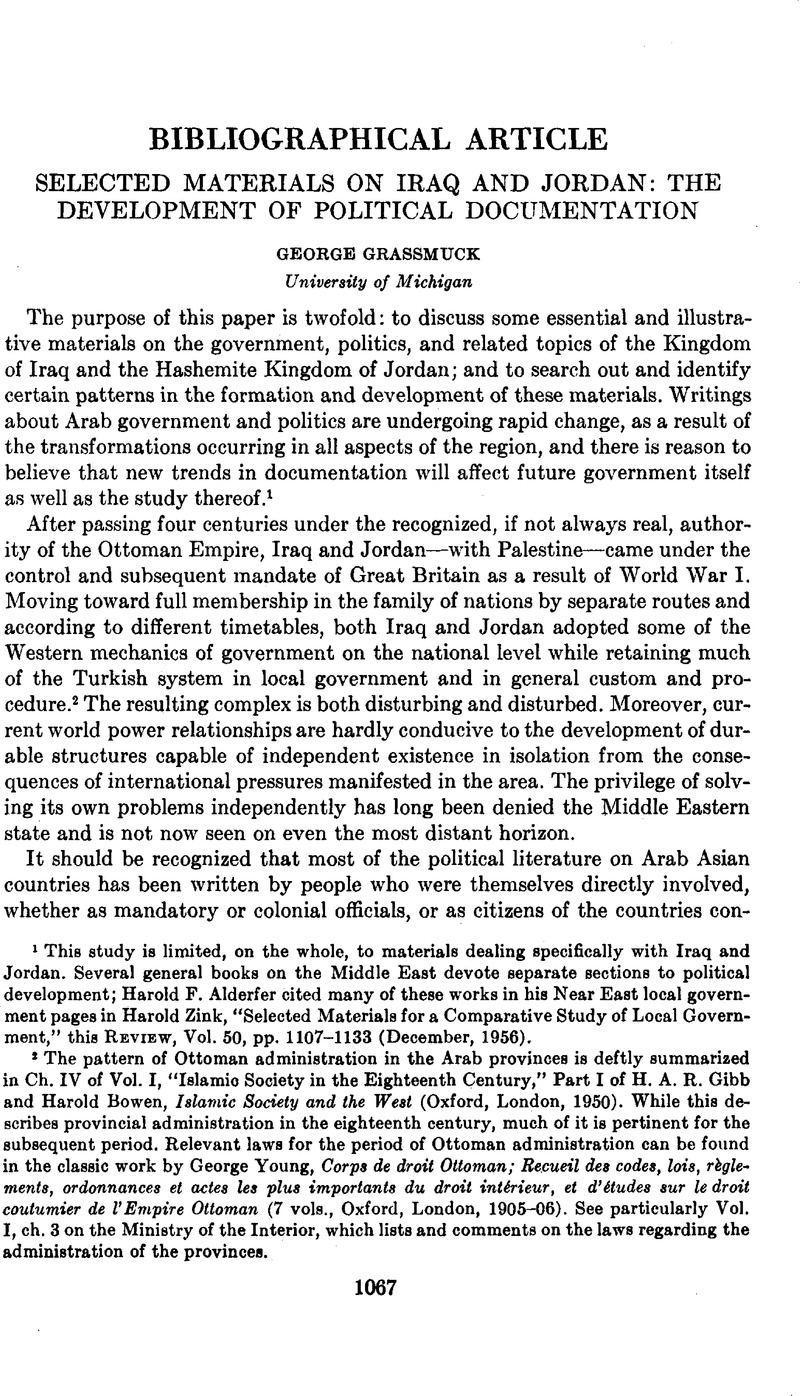No CrossRef data available.
Article contents
Selected Materials on Iraq and Jordan: The Development of Political Documentation
Published online by Cambridge University Press: 02 September 2013
Abstract

- Type
- Bibliographical Article
- Information
- Copyright
- Copyright © American Political Science Association 1957
References
1 This study is limited, on the whole, to materials dealing specifically with Iraq and Jordan. Several general books on the Middle East devote separate sections to political development; Harold F. Alderfer cited many of these works in his Near East local government pages in Zink, Harold, “Selected Materials for a Comparative Study of Local Government,” this Review, Vol. 50, pp. 1107–1133 (December, 1956)Google Scholar.
2 The pattern of Ottoman administration in the Arab provinces is deftly summarized in Ch. IV of Vol. I, “Islamic Society in the Eighteenth Century,” Part I of Gibb, H. A. R. and Bowen, Harold, Islamic Society and the West (Oxford, London, 1950)Google Scholar. While this describes provincial administration in the eighteenth century, much of it is pertinent for the subsequent period. Relevant laws for the period of Ottoman administration can be found in the classic work by Young, George, Corps de droit Ottoman; Recueil des codes, lois, règlements, ordonnances et actes les plus importants du droit intérieur, et d'études sur le droit coutumier de l'Empire Ottoman (7 vols., Oxford, London, 1905–1906)Google Scholar. See particularly Vol. I, ch. 3 on the Ministry of the Interior, which lists and comments on the laws regarding the administration of the provinces.
3 Some insight into political and administrative conditions during the Turkish period can be obtained from Longrigg, Stephen H., Four Centuries of Modern Iraq (Oxford University Press, London, 1925)Google Scholar. In 1954 the British Council Institute, Baghdad, exhibited a selection of British Maps and Books on Iraq published before 1920. The printed catalogue of books exhibited lists nearly 200 items. In 1956 the institute exhibited A Selection of Books, Pamphlets, and Reports on Iraq by British Writers from the end of the Ottoman Administration to the Present Day. The 372 items listed in the printed exhibition catalogue cover a wide range of subjects.
4 Both these publications are currently released by the Publications Department of the Ministry of the Interior (Government Press, Baghdad). The English version has for some years been an official translation of the Arabic and is now about five years behind schedule. While the serial number of recent issues is for 1954, the laws appearing there were issued in the Arabic numbers for 1952.
5 In 1934 another publication in English was the Index of the Laws, Regulations, Proclamations, etc., relating to Iraq, October 31, 1914–Decemher 31, 1933 (Government Press, Baghdad)Google Scholar, but this also has not been continued in an English version. See below under “Legal and Political Documentation” for an account of current legal codification.
6 Hooper, op. cit., p. v.
7 The Constitution appears today in Arabic in the regular collections of Iraqi laws and in the League of Arab States, Institute of Arab Higher Studies, Dasātīr al-Bilād al-'Arabiyyah [Constitutions of the Arab Countries] (Institute of Arab Higher Studies, Arab League, Cairo, 1955), pp. 220–261Google Scholar. Davis, Helen Miller (ed.), Constitutions, Electoral Laws, Treaties of Stales in the Near and Middle East (rev. ed., Duke University Press, Durham, 1953), pp. 151–75Google Scholar, contains the regular English version of the Iraqi Constitution. Both the Arabic and English sources cited include the amendments of 1925 and 1943. The Davis collection also carries the Electoral Law of 1946 (superseded by the new law of 1952, see below), the Anglo-Iraqi Treaty of 1930, and Iraq's Declaration on the Occasion of the Termination of the Mandate in 1932. More recent bilateral agreements involving Iraq—including the Military Assistance Agreement between the United States and Iraq of 1954, the Pact of Mutual Cooperation between Turkey and Iraq of 1955 (Baghdad Pact), and the Special Agreement between Britain and Iraq of 1955—are contained in Vol. II of the collection of documents ed. Hurewitz, J. C., Diplomacy in the Near and Middle East (2 vols., Van Nostrand, New York, 1956)Google Scholar.
8 Wright, , Mandates Under the League of Nations (U. of Chicago Press, Chicago, 1930)Google Scholar describes the League system, as well as the organization for each mandate and its development.
9 Salter, op. cit., preface.
10 Ibid., p. 236.
11 On duplication of statistical functions see Murray, John, A Report on Statistical Organisation in the Government of the Kingdom of Iraq: Including a Scheme for a Centralised Statistical Bureau (Government Press, Baghdad, 1948)Google Scholar.
12 A recent book by a Jordanian civil servant, Nuseibeh, Hazem Zaki, The Ideas of Arab Nationalism (Cornell U. Press, Ithaca, 1956)Google Scholar, may serve as an example of a scholarly work on a general Arab topio, containing some brief references to constitutional development within the Jordanian state.
13 In April 1946 the Amirate was proclaimed the “Kingdom” of Transjordan; while following the Palestine conflict the state became “The Hashenaite Kingdom of the Jordan” and was internationally accepted as such in 1949.
14 The Organic Law of 1928 appears, along with the Anglo-Jordanian treaties of 1928 and 1946, in the Transjordan section of Helen Miller Davis, op. cit., 1947 ed.; while the Constitution of 1946 and the Anglo-Jordanian Treaty of 1948 appear in the revised ed. (1953) of the Davis collection.
15 See the short account of the institution in de Gaury, Gerald, “The End of Pashadom,” Royal Central Asian Journal, Vol. 43, pp. 243–47 (July-October, 1956)CrossRefGoogle Scholar.
16 The 1948 treaty was abrogated following British-Jordanian talks in Amman in March, 1957.
17 P. 60.





Comments
No Comments have been published for this article.